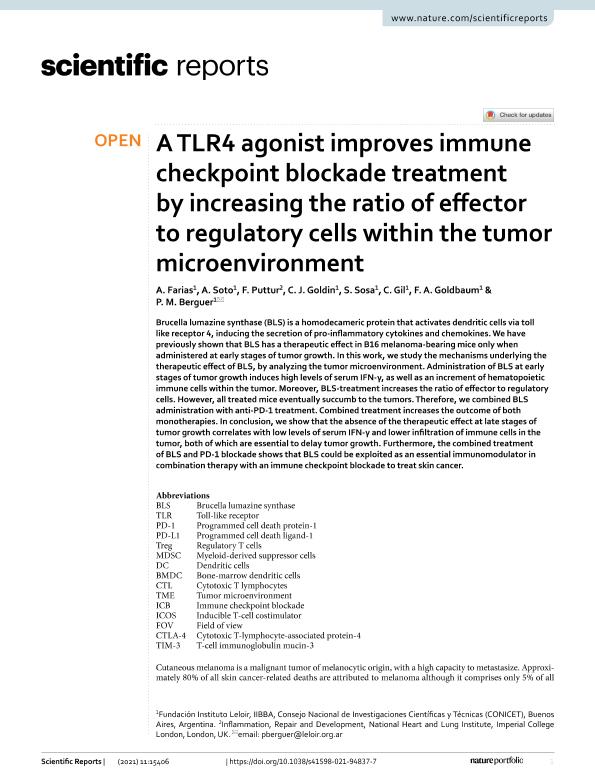Mostrar el registro sencillo del ítem
dc.contributor.author
Farias, Ana

dc.contributor.author
Soto, Ariadna Soledad

dc.contributor.author
Puttur, F.
dc.contributor.author
Goldin, Carla Jimena

dc.contributor.author
Sosa, Santiago

dc.contributor.author
Gil, C.
dc.contributor.author
Goldbaum, Fernando Alberto

dc.contributor.author
Berguer, Paula Mercedes

dc.date.available
2022-06-28T13:35:25Z
dc.date.issued
2021-07
dc.identifier.citation
Farias, Ana; Soto, Ariadna Soledad; Puttur, F.; Goldin, Carla Jimena; Sosa, Santiago; et al.; A TLR4 agonist improves immune checkpoint blockade treatment by increasing the ratio of effector to regulatory cells within the tumor microenvironment; Nature; Scientific Reports; 11; 7-2021; 1-13
dc.identifier.issn
2045-2322
dc.identifier.uri
http://hdl.handle.net/11336/160609
dc.description.abstract
Brucella lumazine synthase (BLS) is a homodecameric protein that activates dendritic cells via toll like receptor 4, inducing the secretion of pro-inflammatory cytokines and chemokines. We have previously shown that BLS has a therapeutic effect in B16 melanoma-bearing mice only when administered at early stages of tumor growth. In this work, we study the mechanisms underlying the therapeutic effect of BLS, by analyzing the tumor microenvironment. Administration of BLS at early stages of tumor growth induces high levels of serum IFN-γ, as well as an increment of hematopoietic immune cells within the tumor. Moreover, BLS-treatment increases the ratio of effector to regulatory cells. However, all treated mice eventually succumb to the tumors. Therefore, we combined BLS administration with anti-PD-1 treatment. Combined treatment increases the outcome of both monotherapies. In conclusion, we show that the absence of the therapeutic effect at late stages of tumor growth correlates with low levels of serum IFN-γ and lower infiltration of immune cells in the tumor, both of which are essential to delay tumor growth. Furthermore, the combined treatment of BLS and PD-1 blockade shows that BLS could be exploited as an essential immunomodulator in combination therapy with an immune checkpoint blockade to treat skin cancer.
dc.format
application/pdf
dc.language.iso
eng
dc.publisher
Nature
dc.rights
info:eu-repo/semantics/openAccess
dc.rights.uri
https://creativecommons.org/licenses/by/2.5/ar/
dc.subject
BLS
dc.subject
MELANOMA
dc.subject
TREATMENT
dc.subject
IMMUNOMODULATOR
dc.subject.classification
Biotecnología relacionada con la Salud

dc.subject.classification
Biotecnología de la Salud

dc.subject.classification
CIENCIAS MÉDICAS Y DE LA SALUD

dc.title
A TLR4 agonist improves immune checkpoint blockade treatment by increasing the ratio of effector to regulatory cells within the tumor microenvironment
dc.type
info:eu-repo/semantics/article
dc.type
info:ar-repo/semantics/artículo
dc.type
info:eu-repo/semantics/publishedVersion
dc.date.updated
2022-06-24T17:22:51Z
dc.journal.volume
11
dc.journal.pagination
1-13
dc.journal.pais
Reino Unido

dc.journal.ciudad
Londres
dc.description.fil
Fil: Farias, Ana. Consejo Nacional de Investigaciones Científicas y Técnicas. Oficina de Coordinación Administrativa Parque Centenario. Instituto de Investigaciones Bioquímicas de Buenos Aires. Fundación Instituto Leloir. Instituto de Investigaciones Bioquímicas de Buenos Aires; Argentina
dc.description.fil
Fil: Soto, Ariadna Soledad. Consejo Nacional de Investigaciones Científicas y Técnicas. Oficina de Coordinación Administrativa Parque Centenario. Instituto de Investigaciones Bioquímicas de Buenos Aires. Fundación Instituto Leloir. Instituto de Investigaciones Bioquímicas de Buenos Aires; Argentina
dc.description.fil
Fil: Puttur, F.. Imperial College London; Reino Unido
dc.description.fil
Fil: Goldin, Carla Jimena. Consejo Nacional de Investigaciones Científicas y Técnicas. Oficina de Coordinación Administrativa Parque Centenario. Instituto de Investigaciones Bioquímicas de Buenos Aires. Fundación Instituto Leloir. Instituto de Investigaciones Bioquímicas de Buenos Aires; Argentina
dc.description.fil
Fil: Sosa, Santiago. Consejo Nacional de Investigaciones Científicas y Técnicas. Oficina de Coordinación Administrativa Parque Centenario. Instituto de Investigaciones Bioquímicas de Buenos Aires. Fundación Instituto Leloir. Instituto de Investigaciones Bioquímicas de Buenos Aires; Argentina
dc.description.fil
Fil: Gil, C.. Fundación Instituto Leloir; Argentina
dc.description.fil
Fil: Goldbaum, Fernando Alberto. Consejo Nacional de Investigaciones Científicas y Técnicas. Oficina de Coordinación Administrativa Parque Centenario. Instituto de Investigaciones Bioquímicas de Buenos Aires. Fundación Instituto Leloir. Instituto de Investigaciones Bioquímicas de Buenos Aires; Argentina
dc.description.fil
Fil: Berguer, Paula Mercedes. Consejo Nacional de Investigaciones Científicas y Técnicas. Oficina de Coordinación Administrativa Parque Centenario. Instituto de Investigaciones Bioquímicas de Buenos Aires. Fundación Instituto Leloir. Instituto de Investigaciones Bioquímicas de Buenos Aires; Argentina
dc.journal.title
Scientific Reports
dc.relation.alternativeid
info:eu-repo/semantics/altIdentifier/url/https://www.nature.com/articles/s41598-021-94837-7
dc.relation.alternativeid
info:eu-repo/semantics/altIdentifier/doi/http://dx.doi.org/10.1038/s41598-021-94837-7
Archivos asociados
